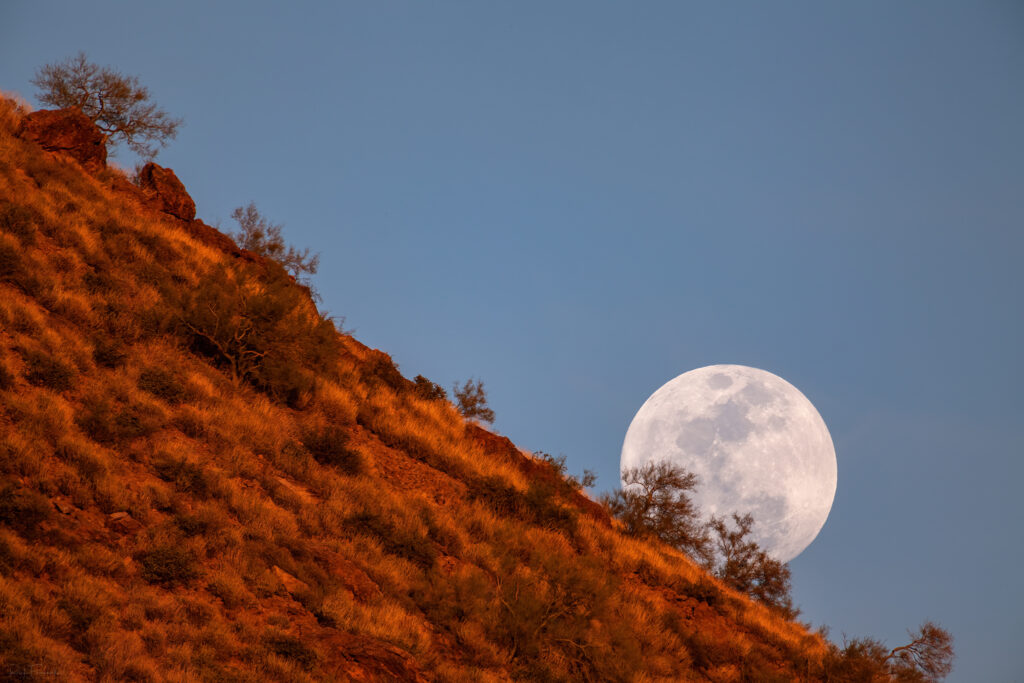Valley of the Moon

Writer Joseph J. Airdo // Photography by Rick Furmanek



Each night in the Sonoran Desert, a silver orb rises silently over craggy mountains and towering saguaros. The moon, ancient and enigmatic, casts its spell over the Arizona landscape, transforming familiar terrain into a realm of mystery and wonder.
“For me, the Arizona desert is unquestionably a magical place to explore,” says Rick Furmanek, a seasoned photographer with a keen eye for the desert’s hidden wonders. “As the sun begins its colorful descent and the moon begins its glorious ascent in concert, something touches me deeply and assures me that in this very moment, I am in a good place.”
Furmanek’s lunar photography transforms Arizona’s diverse landscapes into otherworldly scenes. His images capture the moon rising over saguaro-studded hills, illuminating rocky canyons and casting its glow across the Sonoran Desert. Each photograph tells a story of patience, technical skill and artistic vision.
“I find myself repeatedly invigorated as I witness the reawakening of the desert under a night sky,” he explains.
This month, as thoughts turn to harvest moons and Halloween’s eerie atmosphere, Furmanek’s work takes on an added dimension. His lunar landscapes evoke the mystical quality of the season, reminding viewers of nature’s timeless rhythms.
“While October does not cool down as much as we would like here in the Sonoran Desert, still, there is a sense in the air that things are beginning to change,” Furmanek notes. “That change can reinstill a sense of wanting to get back out into nature.”
Through his lens, Furmanek invites us to experience the magic of Arizona’s moonrises — a spectacle that never fails to captivate him, even after 30 years of exploring the desert Southwest. His images serve as a testament to the enduring allure of our celestial neighbor and the breathtaking beauty of Arizona’s nocturnal landscapes.


















Capturing the Moon
For Rick Furmanek, lunar photography is a delicate balance of technical skill, artistic vision and patience.
“Having worked for Apple a number of years ago, I discovered that I am pretty much utilitarian when it comes to technology,” he explains. “If it proves useful, then I will use it. If not, I’ll pass.”
Furmanek’s favorite locations for capturing moonrises in Arizona include the Fish Creek area along the Apache Trail, Hewitt Canyon Road and Saguaro National Park West. However, he has a special fondness for Peralta Trail Road.
“The opening of Pinal Regional Park on Peralta has provided us with a plethora of new opportunities for composition,” he notes.
One of his most memorable shoots occurred on Hewitt Canyon Road in the eastern Superstitions.
“I dropped below the butte, grabbed my tripod and my long lens, and focused on a saguaro up on the butte’s edge where I thought the moon would continue to rise, and then I waited,” Furmanek recalls. “I wanted both the saguaro and the moon to appear to be about the same size. That became one of my all-time favorite moments.”
To aspiring lunar photographers, Furmanek emphasizes the importance of patience and proper equipment.
“When it comes to lunar work, as well as capturing the night sky, we talk about settings, tripods and patience,” he says. “I remind them that their cameras will capture much more than they can see with the naked eye and not to be discouraged.”
Above all, Furmanek encourages photographers to pursue their craft for personal fulfillment.
“I have learned that I must do this because I want to do it. Because it pleases me,” he reflects. “If I accomplish that and others come alongside me and appreciate my work as well, that is mere icing on the cake.”
About the Photographer



Rick Furmanek’s journey into photography began in the mid-1990s when he served as an operations manager and technical trainer for Apple Computer in Tempe. This experience sparked his transition from film to digital photography, starting with the Apple QuickTake camera.
“Self-taught in both photography and digital processing, I count myself fortunate to have had access to Adobe Photoshop almost daily for more than 20 years,” Furmanek says. “I hope to always remain a student of the craft.”
His work has garnered recognition from prestigious organizations such as National Geographic, Arizona Highways and Outdoor Photographer Magazine. Furmanek has also been featured in live interviews on The Weather Channel, showcasing his monsoon photography.
“I am humbled and count it a privilege to have had my work appreciated by various artists and followers of fine art photography,” he reflects.
For the past three decades, Furmanek has explored Arizona’s desert Southwest, finding endless inspiration in its diverse landscapes. His lunar photography, in particular, captures the magical interplay between the moon and the desert terrain.
“I have always been drawn to the outdoors,” Furmanek explains. “Knowing that I am capturing a moment of creation continues to inspire me to return to the desert.”
As an adjunct instructor at Grand Canyon University, Furmanek shares his passion with students, encouraging them to explore and capture the beauty of nature. His approach to photography balances technical skill with artistic expression, always striving to create images that touch both him and his audience.
“My goal is to work hard at creating something visual that touches me and that others can perhaps appreciate,” Furmanek says, embodying the spirit of a true artist who is continually evolving in his craft.

